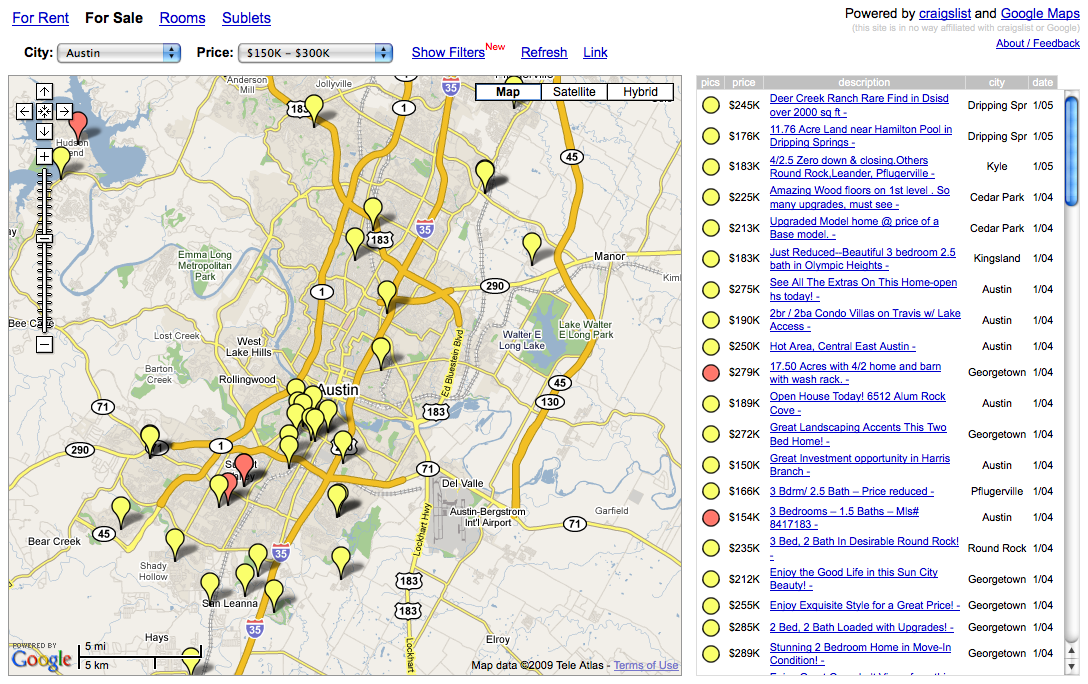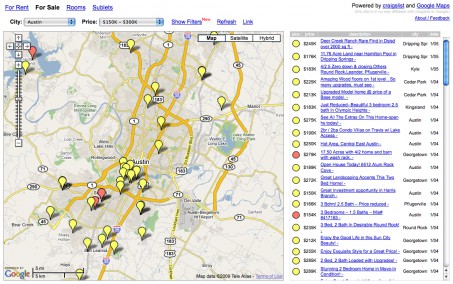
An Introduction to Mashups
The concept of mashups is a simple one: combining separate, typically heterogeneous elements into a single, compound, and useful system. A stick, some rope, and a sharp rock all have their worthy independent uses; but, when combined, they become a spear to make hunting and survival easier. Just as those rudimentary mashups ultimately helped humanity flourish, modern enterprise mashups can produce insights that make modern life better and business more profitable.
The Origin of Mashups
Like many mashups, one of the originals was created to solve a problem. In 2005, before the existence of the Google Maps API, Paul Rademacher searched for housing in San Francisco. He was frustrated that there was no map utility showing all available housing on Craigslist simultaneously. He set out to create a solution.
By tinkering with the Google Maps’ JavaScript, Rademacher combined the capabilities of Google Maps with Craigslist to create his vision.[1] An employee of neither company, he synthesized their offerings to make a revolutionary, ad hoc application that became Housingmaps.com.[2] Google hired him not long thereafter, and enthusiasts and businesses began to create their own mashups. They realized the untapped potential of this novel idea of fusing programs, and the birth of mashups permanently reshaped the digital world.
A screenshot of the Housingmaps mashup for Austin, Texas (Source: Housingmaps.com)
Mashups Undefined
Despite some consensus on general attributes that comprise enterprise mashups, a standard definition does not exist. However, this leaves open the possibility of CIOs and others coming up with their own business interpretations without preconceived notions getting in the way.
The undefined nature of enterprise mashups also contribute to their flexibility. The product of two or more disparate data sets melded together to create powerful hybrids, mashups are not generally projects crafted by IT, but rather by general business users who need fast solutions to immediate problems. Their creation can also span departments, from the supply chain to accounting and customer service.
The sources from which these mashups arise can be internal, external, or a combination. The end goal is often the same: to produce a resource that is more efficient and effective than what is currently available, typically to enhance or automate a routine business process.
Enterprise Mashups in Use
Enterprise Mashups: What Do They Mean for CIOs?, a report compiled by Advanced Practices Council, noted a case in which IBM employees “automated a process that required hours of obtaining and analyzing data, resulting in productivity gains in excess of 50%.”
The report also found that for Kaiser Permanente “the creation of the mashup was driven by the Emergency Room physician’s need to have patient test results as soon as they are available.” Enterprise mashups respond to a need. Though individual needs might differ greatly in scope and context from company to company or issue to issue, business leaders and employees can mashup specific solutions for their problems by combining existing capabilities .
Companies willing to embrace application program interfaces (APIs) for public manipulation of their systems open themselves up to other potential. In having others create program mashups and distributing them, individual brand awareness increases. Amazon.com offers widgets that can be added to external Web pages that link back to its products. Google has an API for its Drive function so it can be integrated with third-party applications. Programmable Web published a list of 13,719 APIs in 2015 alone, and there more than 1,000 for public use at sites like https://publicapis.dev/.
Regardless of whether an organization intends to keep its APIs private, partnered, or public – as mashups will likely spread into all three categories eventually anyway – the creation of those APIs and mashups is the critical element. Businesses need to get people mashing; they can only profit from these arrangements.
At IRI, the graphical ‘Workbench’ IDE that front ends the company’s entire data management and protection line of software products is an amalgamation of Eclipse Plug-Ins. For example, the runtime combination of CoSort with BIRT allows data processing and presentation to occur seamlessly in the same UI. Ironically, the CoSort SortCL program that runs in the background integrates disparate data sources (data mashups) for the benefit of BI and related analytic insights.
For businesses that want to mashup-enable their data there are three rules. Make your API as easy to use as possible, get it out there as soon as possible – this is a fast changing market and if you do not get your data out there, your competitors will – and listen to your users.[3] John Abbott, Technical Consultant – Ordnance Survey
He, She, IT Mashes
The beauty of mashups lies in the scope of who can mash. The capability is not limited only to those who have extensive programming knowledge. And, with the right initiatives in place, the propensity to make mashups can be extended to numerous business departments, without IT intervention. However, mashing may still be better left to IT when more complicated programs are required.
Information leaders can and should implement a business culture that promotes mashups. Corporate forums for sharing ideas and mashups encourage employees to learn to develop mashups of their own. This enables individuals of an organization to address some routine and immediate problems without lengthy approval processes and wait times from IT. It also promotes creativity and empowers employees to improve business operations that directly affect them. Measuring mashups against metrics like speed and decision-making quality can reveal definite and tangible business value.
So, allow Steve the supply chain manager to mashup a system that automates delivery schedules. Let Carly the customer service advisor mashup an interface that automatically brings up all information about a customer in one application window. Anyone who needs a mashup should have the means to create one, if possible. Employees benefit. The enterprise benefits. Life gets easier.
[1] Innovators Under 35: Paul Rademacher. Daniel Charles. MIT Technology Review.
[2] cf. The original thread Rademacher posted encouraging people to test his mashup: https://forums.craigslist.org/?ID=26638141. Provided for historical reference and perspective.
[3] New Routes with Enterprise Mashups. Antony Adshead. ComputerWeekly.











